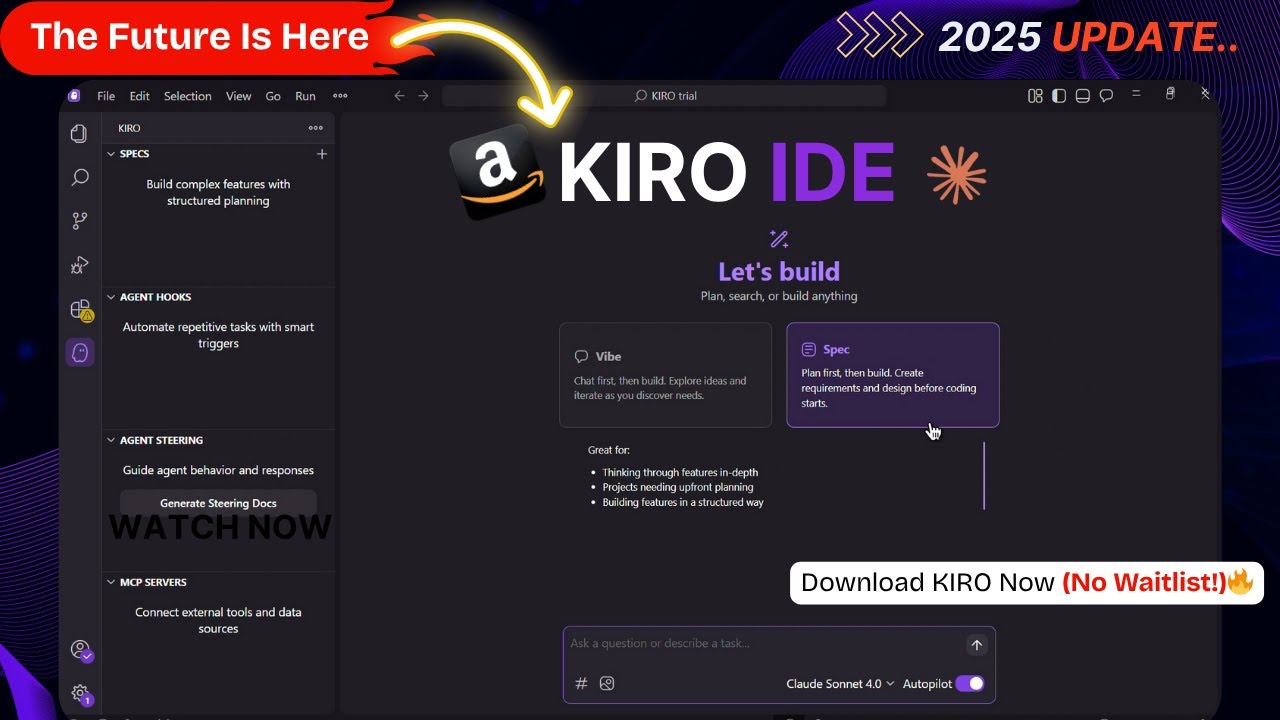Kiro IDE Complete Tutorial: Master Kiro IDE Spec-Driven Development & Agent Hooks

Introduction: Revolutionizing Development with Kiro IDE Structure
Amazon's Kiro IDE represents a paradigm shift in AI-assisted development, introducing "Spec-Driven Development" - a methodology that bridges the gap between the flexibility of "vibe coding" and the clarity of structured specifications. This comprehensive Kiro IDE guide explores how Kiro IDE transforms traditional development workflows through systematic planning and intelligent automation.
Whether you're new to Kiro IDE or looking to master advanced Kiro IDE features, this tutorial covers everything you need to know about maximizing your Kiro IDE experience.
Getting Started: Setup and Interface
Kiro IDE supports all major platforms (Mac, Windows, Linux) and offers seamless integration with existing development environments. The setup process is straightforward:
Authentication Options: Login with Google, GitHub, or Amazon accounts Profile Import: Seamlessly transfer VS Code configurations and preferences Interface Design: Familiar VS Code-based layout with Kiro's distinctive purple theme Cross-Platform Compatibility: Consistent experience across all operating systems
Download Kiro IDE to begin your journey into structured AI development with Kiro IDE.
Two Kiro IDE Development Modes: Flexibility Meets Structure
Kiro IDE offers two distinct approaches to AI-assisted development, catering to different project needs and developer preferences. Understanding these Kiro IDE modes is essential for maximizing your Kiro IDE productivity:
1. Vibe Chat First, Then Build
This traditional mode mirrors other AI IDEs, allowing developers to:
- Provide direct prompts for immediate code generation
- Make real-time changes to the codebase
- Iterate quickly without formal planning
- Perfect for rapid prototyping and experimental development
2. Spec Plan First, Then Build
Kiro's revolutionary approach that emphasizes planning before implementation:
- Systematic requirement gathering and documentation
- Comprehensive design phase with architectural planning
- Structured task breakdown and implementation roadmap
- Ideal for complex projects requiring deep thinking and structured development
The Spec-Driven Development Workflow
Phase 1: Specification Creation
The journey begins with transforming your initial prompt into a comprehensive specification document:
Requirements Generation: Kiro analyzes your input and creates detailed requirements.md files containing:
- User stories with clear acceptance criteria
- Functional and non-functional requirements
- Scope definition and project boundaries
- Success metrics and validation criteria
Assumption Clarification: The AI explicitly states assumptions, allowing you to review and modify before proceeding to implementation.
Iterative Refinement: You can edit and refine requirements until they perfectly capture your vision.
Phase 2: Design Documentation
Once requirements are finalized, Kiro performs deep codebase analysis to create comprehensive design documentation:
Architecture Overview: Complete system architecture with component relationships Technology Stack Analysis: Detailed breakdown of current and recommended technologies Data Flow Diagrams: Visual representation of information flow through the system TypeScript Interfaces: Precise type definitions for all data structures Database Schema: Complete data model with relationships and constraints API Endpoint Specifications: Detailed REST API documentation Visual Documentation: Mermaid diagrams and flowcharts for complex processes
This phase ensures complete understanding before any code is written.
Phase 3: Implementation Planning
The final planning phase creates a detailed execution roadmap:
Task Breakdown: Comprehensive list of implementation tasks and subtasks Dependency Mapping: Clear understanding of task relationships and prerequisites Testing Strategy: Built-in test cases and error handling considerations Quality Assurance: Code review checkpoints and validation steps
Phase 4: Execution
With planning complete, implementation becomes systematic and efficient:
Individual Task Execution: Start tasks individually for granular control Queue Management: Batch multiple tasks for automated sequential execution Progress Tracking: Real-time monitoring of implementation progress Quality Control: Automated testing and validation at each step
Spec Synchronization: Keeping Documentation Current
One of Kiro's most powerful features is bidirectional synchronization between specifications and code:
Code-to-Spec Updates: After manual code changes, request Kiro to update specifications Spec-to-Code Optimization: Modify specifications and have Kiro adjust implementation plans Living Documentation: Specifications remain current throughout the development lifecycle Team Alignment: Ensures all team members work from the same understanding
Agent Hooks: Event-Driven Automation
Agent Hooks represent Kiro's most revolutionary feature - intelligent automation that responds to development events:
How Hooks Work
Event Monitoring: Hooks listen for specific file system events:
- File creation
- File saves
- File deletion
- Custom triggers
Automated Response: When events occur, predefined prompts are sent to AI agents for background execution
Seamless Integration: Automation happens transparently without interrupting your workflow
Practical Hook Applications
Documentation Updates: Automatically update README files when API endpoints change Test Generation: Create or update unit tests when React components are saved Storybook Maintenance: Update component stories when UI components are modified Code Quality: Run linting and formatting checks on file saves Dependency Management: Update package documentation when dependencies change
Creating Custom Hooks
Hook creation uses natural language descriptions:
- Access Hook Management: Click the ghost icon in Kiro's sidebar
- Describe Automation: Use natural language to explain desired behavior
- Configure Triggers: Select appropriate file system events
- Test and Refine: Validate hook behavior with real scenarios
Team Collaboration with Hooks
Version Control Integration: Hooks are saved as files in your repository Team Sharing: Git commits include hook configurations for team consistency Standardization: Ensure uniform practices across all team members Reduced Mental Load: Automate routine tasks that developers often forget
Additional Features and Capabilities
Agent Steering
Create documentation to guide AI agent behavior and responses, similar to custom instructions in other AI assistants. This ensures consistent AI behavior aligned with your project standards.
Context Management
Comprehensive context addition capabilities:
- Files and folders from your codebase
- External documentation and repositories
- Terminal output and system information
- URLs and web resources
- Current file focus for targeted assistance
Model Selection
Currently powered by Claude AI with access to:
- Claude 3.7 for general development tasks
- Claude Sonnet 4 for complex reasoning and architecture decisions
Autopilot Mode
Enabled: Kiro makes changes directly without requesting approval Disabled: All changes require explicit user confirmation before implementation
Pricing and Availability
Current Status
Kiro is currently in preview with all features available free of charge - no credit card required.
Future Pricing Structure
Free Tier: 50 interactions per month including specs, Agent Hooks, and Agent Steering Professional ($19/month): 1,000 interactions per month Enterprise ($39/month): 3,000 interactions per month
Why Spec-Driven Development Matters
Traditional Development Challenges
- Unclear requirements leading to scope creep
- Inadequate documentation causing maintenance issues
- Inconsistent implementation across team members
- Time wasted on rework due to misunderstandings
Kiro's Solution
Automated Specification Writing: AI handles the traditionally unpopular task of documentation Structured Planning: Ensures thorough consideration before implementation Team Alignment: Clear specifications keep everyone on the same page Reduced Rework: Comprehensive planning minimizes costly changes later
The Revolutionary Impact of Hooks
While Spec-Driven Development brings structure to AI coding, Agent Hooks represent the more revolutionary advancement:
Automation of Follow-up Tasks: Eliminates manual steps developers often forget Team Consistency: Ensures uniform practices across all team members Reduced Cognitive Load: Frees developers to focus on creative problem-solving Continuous Quality: Maintains standards automatically throughout development
Best Practices for Kiro IDE
Maximizing Spec-Driven Development
- Invest Time in Requirements: Thorough initial planning saves time later
- Review Each Phase: Don't rush through specification and design phases
- Iterate on Specifications: Refine requirements until they're perfect
- Maintain Sync: Keep specifications updated as code evolves
Effective Hook Usage
- Start Simple: Begin with basic hooks before creating complex automations
- Test Thoroughly: Validate hook behavior in safe environments
- Document Hooks: Maintain clear descriptions of hook purposes
- Share with Team: Ensure all team members understand hook behaviors
Conclusion: The Future of Structured Development
Kiro IDE introduces a fundamentally new approach to AI-assisted development that addresses real problems in modern software engineering. By combining the flexibility of AI coding with the structure of traditional software engineering practices, Kiro offers the best of both worlds.
The Spec-Driven Development methodology ensures that AI assistance is guided by clear requirements and comprehensive planning, while Agent Hooks automate the routine tasks that often fall through the cracks in fast-paced development environments.
For teams serious about maintaining code quality, documentation standards, and development consistency, Kiro IDE represents a significant advancement in AI-powered development tools.
Ready to transform your development workflow? Download Kiro IDE today and experience the power of Spec-Driven Development and Agent Hooks automation.
Related Articles

AI IDE Review: Kiro IDE vs VS Code - Hands-On Testing of Spec-Driven Development
Comprehensive AI IDE review comparing Kiro IDE with VS Code. Real-world testing of AI IDE features including Spec-Driven Development and Agent Hooks automation.

How to Download Kiro IDE 2025: Complete Installation Guide for Windows, Mac & Linux
Step-by-step guide to download and install Kiro IDE on Windows, Mac, and Linux. Get started with Amazon's AI-powered development environment in minutes.

AWS Kiro IDE vs Cursor: Amazon's New AI Development Environment Complete Review
Comprehensive comparison of AWS Kiro IDE and Cursor. Discover how Amazon's new AI-powered IDE challenges Cursor with Claude integration and innovative development features.